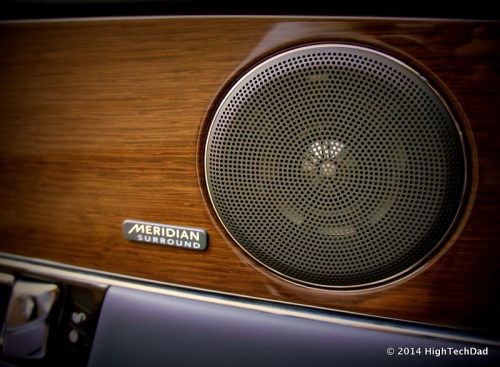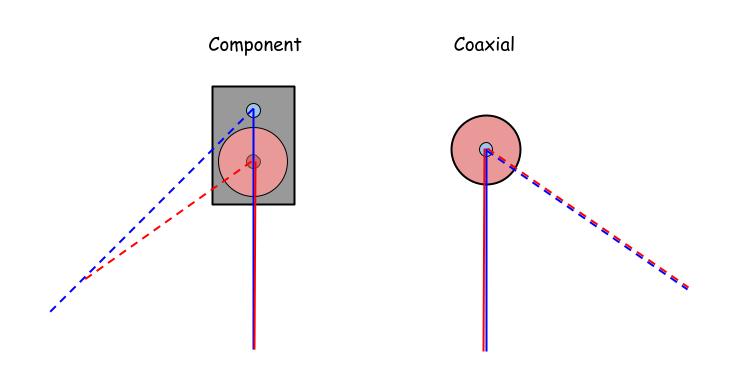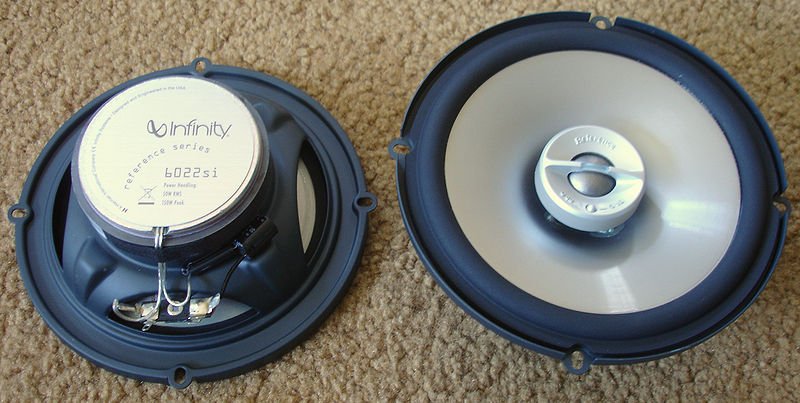Speakers are now built in all kinds of different shapes, sizes, and design styles, and while product variety is largely a good thing in the world of audio, it’s admittedly not all that clear to a non-expert how much any of these things actually influence how good a speaker will sound.
Two common and distinct styles of speaker design are component drivers and coaxial drivers. What are they? how are they different? and which one is better for home audio? That’s what this article is going to discuss.
Article Sections Navigation
What is a coaxial speaker?
A coaxial speaker has multiple drivers that fit into the same cavity on the cabinet and radiate from the same center or “axis” point, and generally look something like this:
You can see on the front side here (the right one) that the tweeter is actually embedded within the midrange woofer and that they share the same center point, or axis as it’s so called.
Most home audio/theater speakers do not actually use a coaxial design but rather a component design, which we’ll discuss momentarily, but there are some manufacturers who do make coaxial bookshelf and tower speakers, and some of them are well regarded and quite popular. Perhaps the most currently recognizable coaxial home audio/theater speakers are the KEFs:


You can see that there’s only a single driver enclosure in the cabinet and that, like the infinity drivers above, the tweeter is concentrically embedded within the woofer.
What is a component speaker?
A component speaker has separate drivers, mainly a smaller tweeter and larger woofer, that each have their own cavity in the cabinet and do not share the same center point. Most bookshelf speaker use a component design where the tweeter sits above the woofer, and look something like this:
What are the advantages of a coaxial over a component speaker design?
The main advantage of a coaxial speaker driver is that it saves space, but this doesn’t really come into play with home audio, and is more a pertinent issue with sound systems in vehicles – cars, boats, etc. – where fitting a speaker that’s even just a few inches larger can be quite difficult and laborious or simply impossible.

Trying to fit a bigger speaker with a separate tweeter is going to be a lot harder to do in a car like above, as you can see, than to simply make room for a bigger bookshelf speaker on your TV stand or what have you.
There is another potential advantage of a coaxial speaker in a home audio set up though: room consistency. That is to say that a coaxial speaker can do a better job sounding the same regardless of where you are in the room, whereas a traditional component speaker might sound noticeably different – and worse – if you stray from the intended focal point.
The reason for this is that, because the tweeter and woofer don’t share the same center, the relative distances between you and the tweeter and woofer will change depending on where you are in the room, and this will inevitably change how a speaker sounds. It’s simple triangular geometry, perhaps most intuitively understood with a diagram:

Most people listening to speakers in a home audio/theater setting are sitting in a designated sweet spot and not moving, so this wouldn’t really be a potential issue. But there are situations where you might want to listen to your speakers while moving around the room, maybe if you’re throwing a party for example, and while these relative distance changes might seem too small to notice, you’d be surprised at how much sound can noticeably differ with simple positional changes. Room consistency is in fact one of the major selling points of the aforementioned coaxial KEF bookshelf speakers.
What are the advantages of a component over a coaxial speaker design?
One of the tricky aspects of a coaxial speaker is that the tweeter and woofer are prone to interfere with each other because they’re both moving around in the same spot. With a component design on the other hand, the tweeter and woofer sit in their own dedicated cavities in the speaker cabinet and can more easily perform without the other’s movements potentially interfering.
Also, when you have some wiggle room with size and positioning when designing a speaker, it’s much easier to use higher quality and/or more performant parts and materials. For example, component speakers almost always have higher quality but inevitably bigger crossovers (the electronic part of the speaker that filters the highs to the tweeter and the mids/lows to the woofer) that simply can’t fit in a coaxial speaker.
Final Verdict: Are Component or Coaxial Speakers Better for Home Audio/Theater?
Component speakers will almost always offer the best overall sound quality for the price. Most home audio/theater speakers use a component design since space and positioning requirements in that setting generally have some flexibility, so there’s just many more of them to choose from for starters, and more product competition will obviously bring more potential value. It’s also easier to optimize physical design and use better parts with a component design.
There are a few situational advantages that a coaxial design can have in a home setting that might make them sound better, and there are some coaxial home audio/theater speakers that are popular and decidedly good, but the advantages or necessity of a coaxial design are mostly related to rigid and limited space requirements in cars, boats, or other such vehicles.


